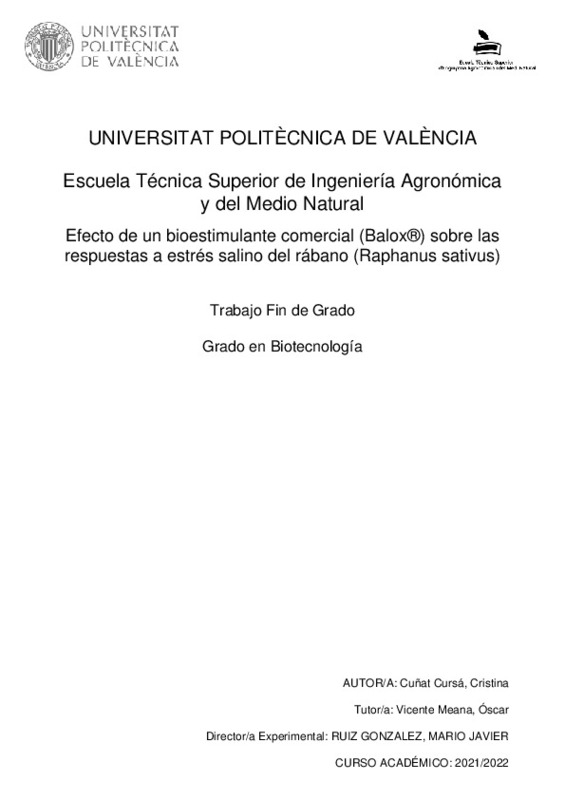|
Resumen:
|
[ES] El rábano (Raphanus sativus) es una especie perteneciente a la familia Brassicaceae, cuyo interés agrícola reside en la obtención de su raíz engrosada, carnosa y pivotante, por tratarse de la parte comestible. Debido ...[+]
[ES] El rábano (Raphanus sativus) es una especie perteneciente a la familia Brassicaceae, cuyo interés agrícola reside en la obtención de su raíz engrosada, carnosa y pivotante, por tratarse de la parte comestible. Debido a su elevado contenido en micronutrientes esenciales como minerales, vitaminas y antioxidantes, presenta un valor dietético excelente por sus beneficios para la salud. Además, dichas propiedades le proporcionan un alto interés comercial, por lo que es de vital importancia la mejora del rendimiento de este cultivo.
El estrés salino afecta de manera sustancial al crecimiento y desarrollo de los cultivos, provocando grandes pérdidas económicas en el sector agrícola, un problema agravado por los efectos del cambio climático. Estudios previos han demostrado que Raphanus sativus presenta una baja tolerancia a este tipo de estrés, observándose cambios en su metabolismo y morfología. Por lo tanto, el desarrollo de estrategias para aumentar la tolerancia del rábano al estrés salino es importante para mejorar su cultivo y rendimiento.
En este trabajo se llevará a cabo un estudio de las respuestas de plantas de Raphanus sativus a tratamientos de estrés salino, en condiciones controladas de invernadero, y el posible efecto protector de un bioestimulante comercial (Balox (R)), aplicado simultáneamente. Este producto contiene polifenoles y glicina betaína como ingredientes bioactivos; su mecanismo de acción parece estar mediado por la activación de vías metabólicas de la planta que aumentan su tolerancia a sal. Las plantas se crecerán en presencia de cuatro concentraciones distintas de NaCl: 0 (control), 50, 100 y 150 mM; para cada tratamiento salino se aplicará el bioestimulante a la mitad de las plantas, a tres dosis de 3 L/ha, utilizándose cinco réplicas por tratamiento (40 plantas en total). Tras los tratamientos, se evaluarán parámetros de crecimiento de las plantas, para establecer el efecto del bioestimulante sobre las plantas control y estresadas. Asimismo, se cuantificarán una serie de marcadores de estrés abiótico (niveles de pigmentos fotosintéticos, iones, osmolitos, marcadores de estrés oxidativo y compuestos antioxidantes), para determinar los posibles mecanismos de acción del bioestimulante.
[-]
[EN] Radish (Raphanus sativus) is a species belonging to the Brassicaceae family, whose agricultural interest lies in obtaining its thickened, fleshy and pivoting root, as it is the edible part. Due to its high content of ...[+]
[EN] Radish (Raphanus sativus) is a species belonging to the Brassicaceae family, whose agricultural interest lies in obtaining its thickened, fleshy and pivoting root, as it is the edible part. Due to its high content of essential micronutrients such as minerals, vitamins and antioxidants, it has an excellent dietary value for its health benefits. In addition, these properties give it a high commercial interest, so it is of vital importance to improve the yield of this crop.
Salt stress substantially affects crop growth and development, causing great economic losses in the agricultural sector, a problem aggravated by the effects of climate change. Previous studies have shown that Raphanus sativus has a low tolerance to this type of stress, with changes in its metabolism and morphology. Therefore, the development of strategies to increase radish tolerance to salt stress is important to improve its cultivation and yield.
In this work, a study of the responses of Raphanus sativus plants to salt stress treatments, under controlled greenhouse conditions, and the possible protective effect of a commercial biostimulant (Balox (R)), applied simultaneously, will be carried out. This product contains polyphenols and glycine betaine as bioactive ingredients; its mechanism of action seems to be mediated by the activation of plant metabolic pathways that increase its salt tolerance. Plants will be grown in the presence of four different concentrations of NaCl: 0 (control), 50, 100 and 150 mM; for each salt treatment, the biostimulant will be applied to half of the plants, at three doses of 3 L/ha, using five replicates per treatment (40 plants in total). After the treatments, plant growth parameters will be evaluated to establish the effect of the biostimulant on control and stressed plants. A series of abiotic stress markers (levels of photosynthetic pigments, ions, osmolytes, oxidative stress markers and antioxidant compounds) will also be quantified to determine the possible mechanisms of action of the biostimulant.
[-]
|







